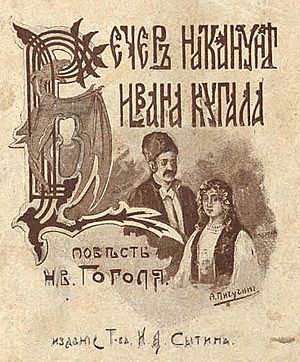St. John's Eve (short story) facts for kids
Quick facts for kids "St. John's Eve" |
|
|---|---|

Cover of illustrated publication of St. John's Eve (1909)
|
|
| Author | Nikolai Gogol |
| Original title | "Вечер накануне Ивана Купала" |
| Translator | Isabel Florence Hapgood |
| Country | Russian Empire |
| Language | Russian |
| Series | Evenings on a Farm Near Dikanka |
| Genre(s) | horror |
| Published in | Otechestvennye Zapiski |
| Publication type | literary magazine |
| Media type | Print (periodical) |
| Publication date | February–March 1830 |
| Published in English | 1886 |
| Preceded by | "The Fair at Sorochyntsi" |
| Followed by | "May Night" |
St. John's Eve (Russian: Вечер накануне Ивана Купала; translit. Večer nakanune Ivana Kupala), also called "The Eve of Ivan Kupala," is a spooky short story. It is the second story in the book Evenings on a Farm Near Dikanka by Nikolai Gogol. The story first appeared in a magazine called Otechestvennye Zapiski in 1830. It was then published in a book in 1831.
Story Summary
This tale is told by Rudy Panko, who heard it from Foma Grigorievich. Foma is a church helper in Dikanka. Foma stops Rudy from reading and insists on telling the story his own way.
Foma's grandfather lived in an old village that no longer exists. In that village lived a Cossack (a type of warrior and farmer) named Korzh. Korzh had a daughter named Pidorka and a worker named Petro. Petro and Pidorka fell in love.
One day, Korzh saw Pidorka and Petro kissing. He was about to punish Petro. But Korzh's son, Ivas, begged his father not to hurt the worker. So, Korzh took Petro outside and told him to never come back. Petro and Pidorka were very sad.
Petro wanted to see Pidorka again more than anything. He met a strange man named Basavriuk. Villagers thought Basavriuk might be the devil himself. Basavriuk told Petro to meet him in Bear’s Ravine. There, Petro could find treasure to help him reunite with Pidorka.
When Petro arrived, Basavriuk told him to find a special fern. This fern blooms only on Kupala Night. When Petro picked the flower, a witch appeared. She gave him a spade. Petro dug up a treasure, but he could not open it without blood. He was ready to use his own blood. But then, Ivas appeared, captured by the witch. Petro did not want to hurt Ivas. However, he was very confused and desperate. He harmed the child, and then he got the gold.
Petro immediately fell asleep for two days. When he woke up, he saw the gold. But he could not remember how he got it. Petro used the gold to make Korzh happy. He then married Pidorka. After they married, Petro became distant and seemed to lose his mind. He kept thinking about what he had forgotten.
As a last hope, Pidorka visited the witch for help. She brought the witch to their home. When Petro saw the witch, he remembered everything from that night. He threw an axe at the witch, and she vanished. Then, Ivas appeared at the door, looking hurt. The devil then took Petro away. All that was left was a pile of ashes where Petro had stood. The gold had turned into broken pottery pieces.
After this, Basavriuk started appearing in the village again. Pidorka went on a long religious journey. Foma’s grandfather’s aunt still had problems with the devil. For example, a party was ruined when a roasted lamb came alive. A cup bowed to his grandfather, and a bowl started dancing. Even after sprinkling holy water everywhere, the tavern seemed haunted. So, the village was left empty.
Story Background
This story takes place in a Ukrainian village. Nikolai Gogol used details about Ukrainian food and customs in the story. For example, he described the wedding of Petro and Pidorka. He also described the witch's face as "like a baked apple." The story also shows the complicated wedding traditions of Ukraine. The time of year, a holiday season, is also important to the plot.
St. John's Eve is like a Kunstmarchen. This is a type of fairy tale that feels real or is based on folk stories. It is told by a specific narrator. Foma Grigorievich, the storyteller, believes his grandfather's stories have magical power. In St. John's Eve, like in other Gogol stories, the normal rules of nature are often broken. For instance, the devil's gifts can float on water.
The story starts like a funny love story. But it ends as a "romantic horror" tale.
Story's Importance
This short story was a big inspiration for a famous Russian composer, Modest Mussorgsky. He wrote a piece of music called Night on Bald Mountain. This music became very well known because it was used in Disney's movie Fantasia. Mussorgsky had actually planned to make an opera based on the story first, but he stopped that project.
Some people have compared Nikolai Gogol's work to that of Oscar Wilde. The part where Ivas is harmed is similar to a murder in Wilde's story Lord Arthur Savile's Crime. In both stories, something bad happens to an innocent person before a marriage can take place.
Movie Version
The story was made into a movie called The Eve of Ivan Kupala. It was made in the Ukrainian SSR (part of the Soviet Union at the time). Yuri Ilyenko directed the film. It starred Larisa Kadochnikova and Boris Khmelnitsky. The movie came out in the Soviet Union in February 1969.

